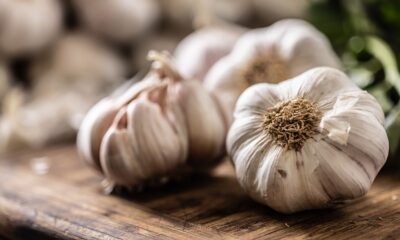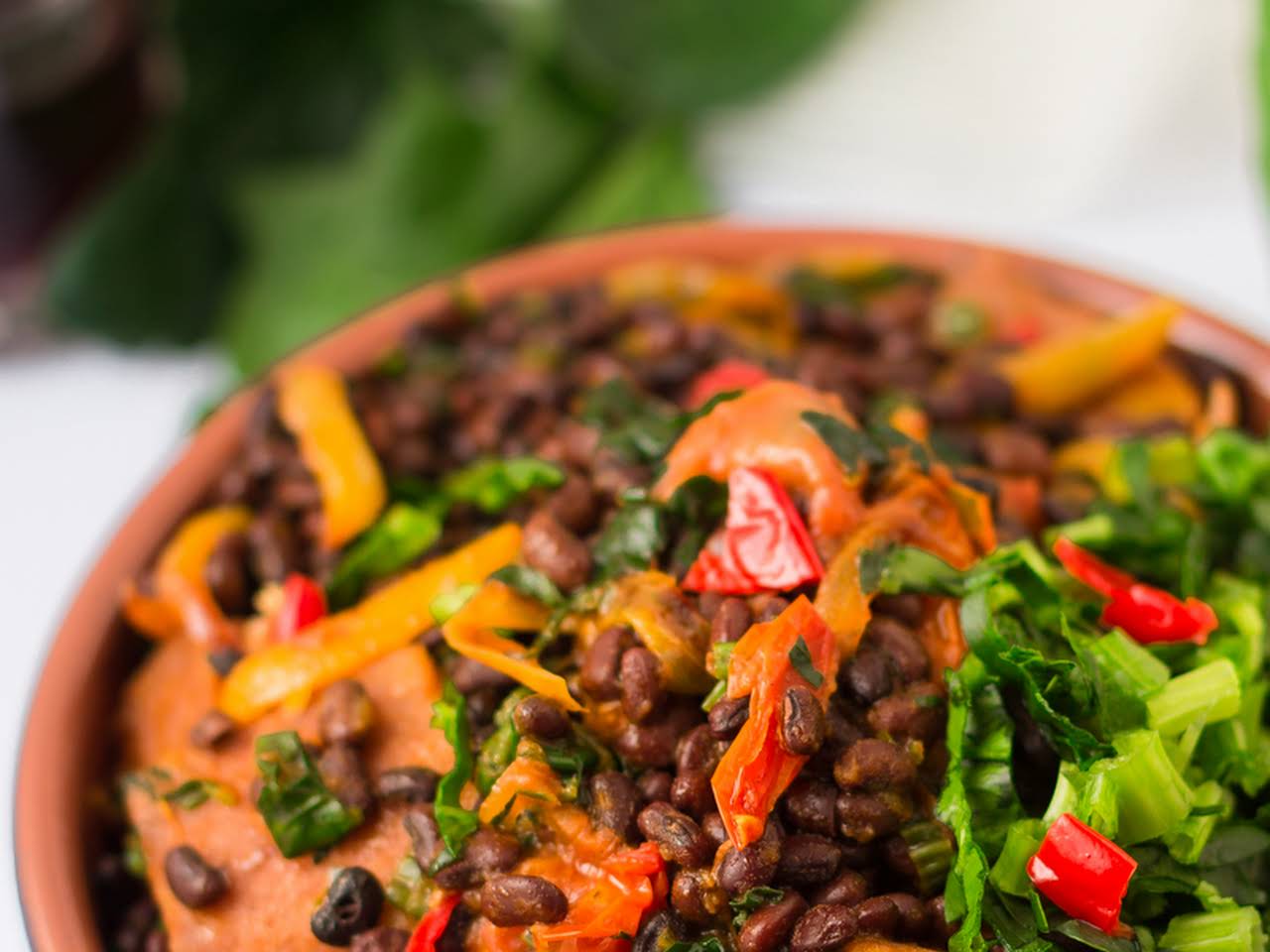FOOD
7 Potential Health Benefits Of Green Beans
Published
1 year agoon
By
wpadminee
While green veggies like kale, spinach, and broccoli often steal the spotlight in discussions about healthy foods, green beans are nutritional powerhouses that deserve attention.
They are packed with nutrients while being low in calories, making them an excellent choice for overall health. They are also known as string beans or snap beans, and come in various shades, including yellow, purple, or red-speckled varieties.
Originating from Central and South America, green beans have two main types: bush and pole beans, with a total of 130 varieties. Bush beans can grow without support, while pole beans require a pole for climbing. Whether fresh or frozen, green beans retain their nutritional value, providing essential nutrients like protein, carbohydrates, fibre, and minimal fat.
To enjoy the benefits of green beans, you can incorporate them into various dishes and make them a valuable addition to your diet.
1. Green Beans keep the bones strong.
Green beans play a role in maintaining strong bones due to their excellent vitamin K content. Vitamin K is crucial for producing proteins essential in bone formation.
Studies indicate that a vitamin K-rich diet is associated with improved physical function and a reduced risk of injuries, such as hip fractures, particularly in older women. Additionally, green beans contain calcium, a vital nutrient for bone health.

Inadequate calcium intake or absorption can lead to weakened bones or improper growth. Therefore, incorporating green beans into your diet contributes to the overall health of your bones.
2. Its vitamin C content supports the immune system.
Eating a diet rich in vitamin C from vegetables and fruits is crucial for supporting optimal immune system function. Green beans, recognized as a good source of vitamin C, contribute to antioxidant effects that promote immune health, and collagen production, and aid in the absorption of nonheme iron found in plant-based sources like green beans.
Vitamin C plays a key role in combatting infections and promoting wound healing. Additionally, its antioxidant properties help counteract free radicals, thereby contributing to the prevention or mitigation of diseases like cancer and heart disease.
While vitamin C may not entirely prevent the common cold, consistently including vitamin C-rich foods in the diet (at least 200 milligrams per day) may reduce the severity and duration of cold symptoms for some individuals.
3. It keeps you full.
They can serve as a valuable source of fibre. The advantages of incorporating fibre into your diet are numerous. Fibre is an often overlooked nutrient that aids in creating a prolonged feeling of fullness after meals and helps stabilize blood sugar levels.
Fibre adds volume to contribute to a sense of satiety, and its slow digestion compared to low-fibre foods can be beneficial. High-fibre foods like green beans are typically lower in calories, potentially supporting weight loss.
4. It contains minerals and nutrients that help the heart.
The fibre found in green beans offers heart-healthy benefits, including the lowering of triglyceride and cholesterol levels. Additionally, green beans contain heart-healthy vitamins and minerals, such as potassium.
Get the latest and greatest updates right away! Join our exclusive Whatsapp Channel and never miss out on exciting news again.
Potassium plays a role in reducing blood pressure, and a study suggests a link between a high-potassium diet and lower blood pressure, particularly in women. This association also implies that a potassium-rich diet may mitigate the adverse effects of a high-sodium diet.
:max_bytes(150000):strip_icc()/230103-buttery-garlic-green-beans-DDMFS-4x3-43cfc64c1dae47d5897f7bee21f21cda.jpg)
They are also a source of folate, a type of vitamin that supports heart health. Folate may decrease the risk of stroke by helping break down homocysteine, an amino acid that could potentially harm the inner walls of arteries. Folic acid supplementation reduces the likelihood of stroke in patients with cardiovascular disease.
While green beans may not meet all daily folate needs or match the levels provided by supplements, they can contribute to heart health, particularly when combined with other healthy habits like consuming a variety of vegetables and fruits and engaging in regular exercise.
5. It helps the gut microbiome.
The fibre present in green beans not only aids in maintaining a smooth digestive system but also provides additional digestive benefits. The fibre positively influences the gut microbiome, consisting of tiny organisms crucial for food digestion and nutrient absorption.
Fibre supports the growth of beneficial bacteria in the intestines, contributing to optimal digestive health. These microorganisms utilize the fibre as a nutrient source, promoting their proliferation.
Moreover, green beans contain pectin, a gel-like starch, classified as a specific type of fibre, that plays a role in supporting the cellular lining of the intestines. It not only reduces the likelihood of bacterial infections but also contributes to the essential diversity of gut bacteria.
6. It helps you feel more energized.
Green beans also contribute to this need by providing the essential mineral iron, crucial for preventing fatigue. Iron is a vital component of haemoglobin, a protein in red blood cells responsible for carrying oxygen to muscles.
A low dose of iron supplementation can assist in combating fatigue. Although green beans may not fulfil all your daily iron requirements, you can incorporate other iron-rich foods like poultry, seafood, nuts, and beans, and avoid relying solely on supplements.
Additionally, green beans contribute to meeting your daily protein goals, containing about 2 grams of protein per cup of raw vegetables. So including green beans, offer plant-based protein.
Incorporating this vegetable into your diet can be a wholesome way to support your energy levels through a combination of essential nutrients.
Check here for more updates.
You may like
-


4 Tips For A Stress-Free Cooking Experience This Christmas
-


5 Ways To Stay Healthy This Christmas Season
-


5 Health Benefits Of Cooking With Garlic
-


Are Alcoholic Drinks Only Harmful? See Surprising Health Benefits
-


How To Stay Healthy While Boosting Productivity
-


Here’s The Best Recipe For Making Rice Fritters
FOOD
4 Tips For A Stress-Free Cooking Experience This Christmas
Published
3 months agoon
December 22, 2024By
wpadminee
The Christmas season is a time for joy, family, and delicious meals. However, cooking can often feel overwhelming, especially with the holiday hustle. With the right approach, cooking Christmas meals can be a stress-free experience.
Here are four practical tips for a stress-free cooking experience this Christmas.
1. Plan Ahead for Every Detail
Preparation is the key to success in the kitchen. Start by creating a detailed menu. Write down the dishes you want to make, the ingredients you need, and the estimated time for each recipe. This planning ensures you stay organised.
Invest time in grocery shopping early. Stores can be crowded closer to Christmas, so getting what you need in advance helps avoid the rush.
Batch-process tasks like peeling vegetables or marinating meat a day or two before. Following these tips for stress-free cooking keeps last-minute chaos at bay.
2. Simplify Your Menu
Christmas meals don’t need to be extravagant to be memorable. Focus on a few key dishes that everyone loves rather than a spread that leaves you exhausted. Choose recipes that are easy to prepare and don’t require constant attention.
For desserts, consider make-ahead options like pies or cookies. These can be prepared in advance, allowing you to spend more time with your guests. Simplifying your menu is one of the best tips for stress-free cooking this Christmas.
3. Use Time-Saving Tools and Techniques
Modern kitchen gadgets are lifesavers during Christmas. Slow cookers, food processors, and stand mixers can help speed up the process while reducing effort.
For large meals, use your oven efficiently. Bake multiple dishes at once if they require the same temperature. Pre-chop ingredients or buy pre-cut options to save valuable time.
Embrace these tips for stress-free cooking to make your holiday meal prep smoother and faster.
4. Delegate and Involve Others
You don’t have to do everything yourself. Share the workload with family or friends. Assign simple tasks like setting the table, washing vegetables, or stirring sauces to others.
If guests offer to bring a dish, accept their help. Potluck-style dinners reduce your cooking burden while adding variety to the table.
Delegating responsibilities is among the most effective tips for stress-free cooking, ensuring you enjoy the process too.
Cooking for Christmas doesn’t have to be a source of stress. By planning ahead, simplifying your menu, using time-saving techniques, and involving others, you can create a joyful and memorable meal.
These four tips for stress-free cooking will not only lighten your load but also let you focus on the true spirit of the season: togetherness and gratitude.
Keep these strategies in mind as you prepare your holiday feast. Merry Christmas and happy cooking!
For more reads, visit here.
FOOD
3 Delicious Recipes For Making Akidi (Black Beans)
Published
4 months agoon
December 8, 2024By
wpadminee
Akidi (black beans) recipes are a cornerstone of Enugu State’s culinary heritage, enjoyed widely across Nigeria and Africa. This versatile legume, rich in protein, fibre, and essential vitamins, makes it a nutritious staple in many homes.
Originating from Enugu, akidi holds a special place in traditional dishes, offering robust flavour and health benefits.
If you’re looking to expand your cooking repertoire, these three delicious akidi (black beans) recipes will elevate your meals.
Whether you’re an experienced chef or a kitchen novice, each akidi (black beans) recipe provides a unique taste experience.
Embrace the richness of Enugu’s culture and impress your family with these flavourful and nutritious dishes featuring the beloved black beans.
Recipe 1: Classic Akidi Soup
Ingredients:
- 1 cup dried black beans (akidi)
- 1 large onion, chopped
- 2 scotch bonnet peppers, chopped
- 2 tablespoons palm oil
- 1 teaspoon dried crayfish
- 1 teaspoon salt
- 1/2 teaspoon black pepper
- 1 stock cube
- Water
Instructions:
- Soak the beans: Rinse the black beans and soak them in water overnight.
- Cook the beans: Drain the soaked beans and add them to a pot with fresh water. Bring to a boil, then reduce heat and simmer until the beans are tender.
- Sauté the aromatics: Heat the palm oil in a separate pot. Add the chopped onion and scotch bonnet peppers, and sauté until fragrant.
- Combine the ingredients: Add the sautéed ingredients to the pot of cooked beans. Stir in the dried crayfish, salt, black pepper, and stock cube.
- Simmer and serve: Simmer the soup for an additional 10-15 minutes, or until the flavours are well combined. Serve hot.
Recipe 2: Akidi with Spinach and Plantain

Ingredients:
- 1 cup cooked black beans (akidi)
- 1 bunch spinach, chopped
- 2 ripe plantains, sliced
- 1 onion, chopped
- 2 cloves garlic, minced
- 1 teaspoon ginger, grated
- 1 teaspoon curry powder
- 1/2 teaspoon turmeric powder
- Salt to taste
- Vegetable oil
Instructions:
- Heat the vegetable oil in a pot. Add the onion, garlic, and ginger, and sauté until fragrant.
- Add the spinach: Add the chopped spinach to the pot and stir until wilted.
- Combine the ingredients: Add the cooked black beans, curry powder, and turmeric powder to the pot. Stir to combine.
- Fry the plantains: In a separate pan, fry the plantain slices until golden brown.
- Serve: Serve the akidi and spinach mixture with the fried plantains.
Recipe 3: Akidi with Smoked Fish and Vegetables

Ingredients:
- 1 cup cooked black beans (akidi)
- 1 smoked fish, crumbled
- 1 large onion, chopped
- 2 carrots, diced
- 1 green bell pepper, diced
- 1 teaspoon thyme
- 1/2 teaspoon black pepper
- Salt to taste
- Vegetable oil
Instructions:
- Heat the vegetable oil in a pot. Add the onion, carrots, and bell pepper, and sauté until softened.
- Add the beans and smoked fish: Add the cooked black beans and crumbled smoked fish to the pot. Stir to combine.
- Season and simmer: Season with thyme, black pepper, and salt. Simmer for 10-15 minutes, or until the flavours are well-combined.
- Serve: Serve the akidi with smoked fish and vegetables hot with rice, yam, or bread.
These three akidi (black beans) recipes are just a starting point. Feel free to experiment with different ingredients and flavours to create your own unique dishes.
Remember, the key to a delicious akidi dish is to use high-quality ingredients and to cook slowly to allow the flavours to develop.
Whether you’re a seasoned cook or a novice in the kitchen, these akidi (black beans) recipes are a great way to enjoy this nutritious and flavourful legume.
For more articles on food recipes, visit here.
FOOD
5 Health Benefits Of Cooking With Garlic
Published
4 months agoon
December 7, 2024By
wpadminee
Garlic is more than just a flavour enhancer; it offers numerous health benefits that have been celebrated for centuries. Incorporating garlic into your meals not only enriches the taste but also boosts your overall well-being.
Let’s explore five key health benefits of garlic, emphasising why this simple ingredient deserves a spot in your kitchen.
1. Boosts Heart Health
Garlic is renowned for its heart-protective properties. It helps lower blood pressure and reduces cholesterol levels, which are crucial factors in maintaining cardiovascular health.
Allicin, a compound found in garlic, relaxes blood vessels, improving blood flow and reducing the risk of heart disease.
Regular consumption of garlic may also prevent artery hardening, a condition known as atherosclerosis. Clearly, one of the primary health benefits of garlic is its contribution to a healthy heart.
2. Strengthens the Immune System
Garlic acts as a powerful immune booster. Its antibacterial, antiviral, and antifungal properties help the body fend off infections. Rich in antioxidants, garlic combats free radicals that can damage cells and contribute to illness.
Cooking with garlic regularly can support your immune system, making it more resilient against common colds and flu. This vital health benefit of garlic makes it a natural defence mechanism.
3. Improves Digestive Health
Garlic promotes healthy digestion by stimulating the production of digestive enzymes. Its antimicrobial properties can help balance gut flora, reducing harmful bacteria and promoting beneficial ones.
Additionally, garlic may reduce inflammation in the gut, alleviating symptoms of conditions like irritable bowel syndrome (IBS).
Including garlic in your diet can improve overall digestive function, emphasising another essential health benefit of garlic.
4. Enhances Bone Health
Surprisingly, garlic may also support strong bones. It contains minerals like calcium, manganese, and selenium, which are vital for bone density and strength.
Some studies suggest that garlic consumption can increase estrogen levels in women, potentially reducing the risk of osteoporosis.
This lesser-known health benefit of garlic highlights its role beyond the kitchen, contributing to long-term skeletal health.
5. Supports Detoxification
Garlic aids the body’s natural detoxification process by activating liver enzymes that help eliminate toxins. Its sulfur compounds enhance liver function, enabling the body to flush out heavy metals and harmful substances more efficiently.
Regularly cooking with garlic can provide a natural cleanse, supporting overall vitality. This detoxifying health benefit of garlic underscores its importance for maintaining internal balance.
Incorporating Garlic into Your Diet
Maximise these health benefits by adding garlic to soups, stir-fries, and sauces. Crush or chop it and let it sit for a few minutes before cooking to enhance its beneficial compounds.
Remember, the health benefits of garlic are most potent when it’s used fresh and minimally cooked.
Cooking with garlic not only elevates your culinary creations but also offers significant health advantages. Embrace this versatile ingredient and enjoy the multiple health benefits of garlic with every meal.
Would you like more articles or additional tips? Check here.
Latest


Samsung Galaxy S25 Series Sets The Standard Of AI Phones As A True AI Companion
Samsung Galaxy S25 series sets the standard of AI phones as a true AI companion …Pioneering the multimodal era with...


5 Things To Expect In Afrobeats In 2025
Afrobeats is poised to reach unprecedented heights in 2025 as Nigerian music continues its remarkable global ascent. The genre’s explosive...


Here Are The 7 Most Ancient Countries On Earth
The oldest countries in the world stand as remarkable testaments to human civilisation, each containing landscapes and monuments that narrate...


Why Self-Reflection Is More Important Than Resolutions
Millions of people embark on a yearly ritual: they sit down with a notebook and pen, eager to craft a...


Nollywood Director, Kemi Adetiba Teases King Of Boys 3
Nollywood director Kemi Adetiba has revealed that another instalment of King of Boys will be released on December 25, 2025....


John McEnroe Says He Can Be The Commissioner Tennis Needs Amid Doping Crisis
Recent doping controversies involving top players have not damaged tennis’s reputation, but John McEnroe believes that appointing a single commissioner...


“Everybody Loves Jenifa” Becomes Nollywood’s Highest-Grossing Film Of All Time
Nollywood filmmaker Funke Akindele has achieved a historic milestone with her latest film, “Everybody Loves Jenifa.” The film has officially...


FG To Premiere TV Series, “Hidden Riches” On Mining Sector On January 25
Nigeria’s Federal Government will launch an ambitious television drama series focused on the nation’s mining sector, premiering “Hidden Riches” on...


Qing Madi Delivers A Soulful Performance Of “Favourite Pyscho”
Rising Afro-RnB sensation Qing Madi launches into 2025 with a mesmerising performance on the prestigious COLOURS platform, showcasing her latest...


Taiwo Awoniyi’s First Goal Of The Season Seals Nottingham Forest’s Win Over Wolves
Taiwo Awoniyi made a triumphant return to Premier League action. He scored in stoppage time to help Nottingham Forest crush...
-Ad-





